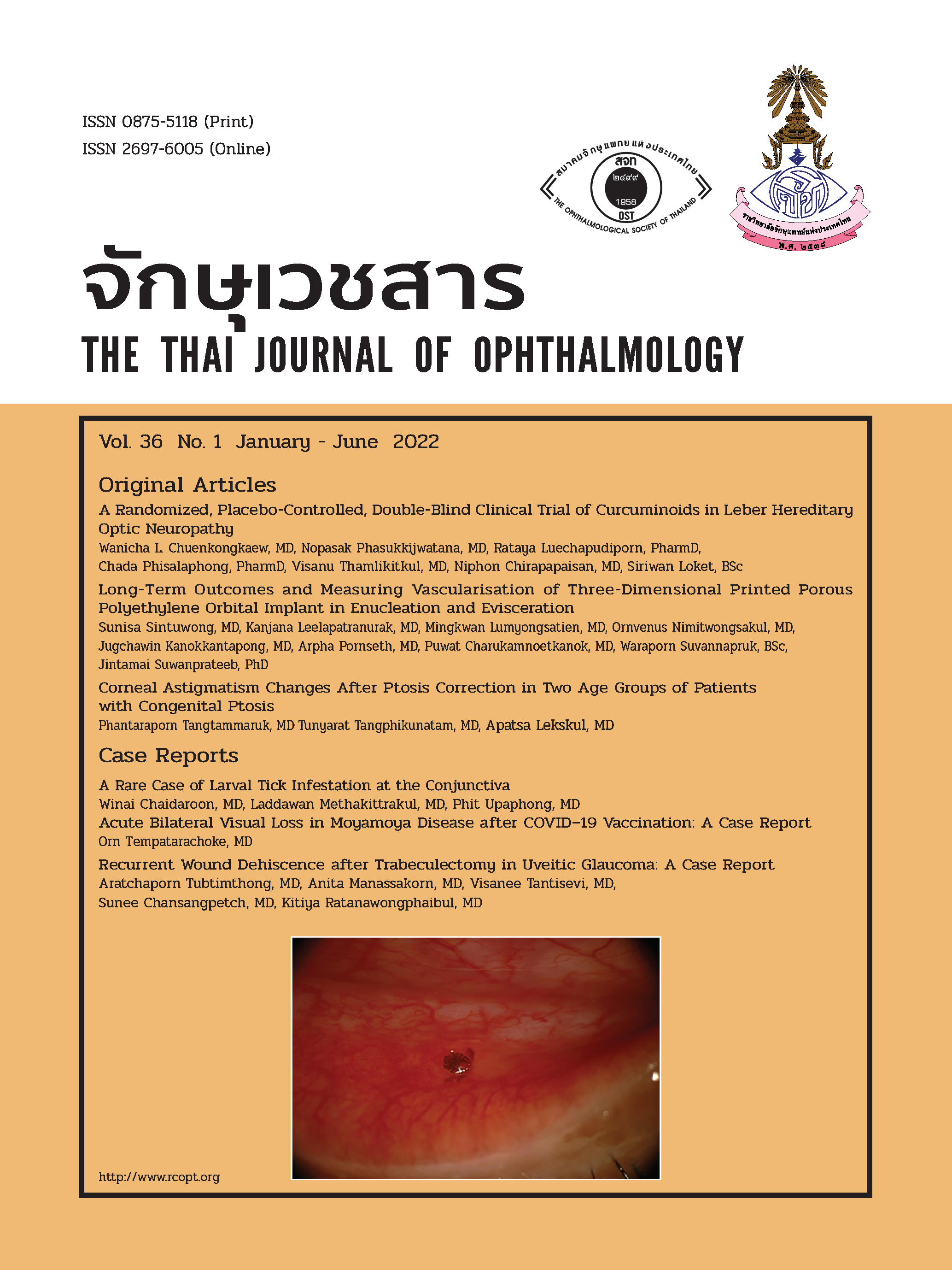Long-Term Outcomes and Measuring Vascularisation of Three-Dimensional Printed Porous Polyethylene Orbital Implant in Enucleation and Evisceration
Keywords:
Prosthesis, Orbit, Reconstruction, EyeAbstract
Objective: To report the long-term outcome in terms of safety and efficacy of a new three-dimensional printed
polyethylene (3DP-PE) orbital implant in patients who required orbital reconstruction after eye removal and to measure
area of fibrovascular ingrowth in the orbital implant by using ImageJ software.
Methods: Prospective, consecutive selection in 21 patients which met the criteria. Each case had evisceration,
enucleation, or secondary orbital implant performed by one of three oculoplastic surgeons. A gadolinium-enhanced,
1.5-Tesla MRI scan was performed at least 6 months after surgery. The follow-up time was at least 12 months. Safety
was measured in terms of infection and tissue reaction to the implant. Efficacy was measured in terms of exposure rate,
grades of fibrovascular ingrowth and postoperative results in long-term follow-up. Comparison of vascularisation of
first and second MRI scans was measured by subjective technique and ImageJ software.
Results: The mean age was 40.4 ± 15.3 years old (range, 18-73 years old). 57.1% of patients had evisceration
procedures. The mean follow-up time was 64.0 ± 37.4 months (range, 18-128 months). No postoperative infection was
reported. The exposure rate was 19%. A total of four patients had two MRI scans and 75% of patients had increased
enhancement at the second MRI scan, using subjective technique and ImageJ software. The correlation in interpretation
of enhancement techniques between subjective technique and ImageJ software was 50%.
Conclusion: A 3DP-PE orbital implant is safe in terms of infection rate in long term follow-up.
References
Shields CL, Shields JA, Eagle RC, Jr., De Potter P. Histopathologic evidence of fibrovascular ingrowth four weeks after placement of the hydroxyapatite orbital implant. Am J Ophthalmol. 1991;111:363-366.
Suwanprateeb J, Suvannapruk W, Wasoontararat K, Leelapatranurak K, Wanumkarng N, Sintuwong S. Preparation and comparative study of a new porous polyethylene ocular implant using powder printing technology. J Bioact Compat Polym. 2011;26:317-331.
Sosakul T, Tuchpramuk P, Suvannapruk W, Srion A, Rungroungdouyboon B, Suwanprateeb J. Evaluation of tissue ingrowth and reaction of a porous polyethylene block as an onlay bone graft in rabbit posterior mandible. J Periodontal Implant Sci. 2020;50:106-120.
Suwanprateeb J, Thammarakcharoen F, Wongsuvan V, Chokevivat W. Development of porous powder printed high density polyethylene for personalized bone implants. J Porous Mater. 2011;19:623-632.
Suwanprateeb J, Kerdsook S, Boonsiri T, Pratumpong P. Evaluation of heat treatment regimes and their influences on properties of powder printed high density polyethylene bone implant. Polym Int. 2010;60:758-764.
Suwanprateeb J, Thammarakcharoen F, Suvannapruk W. Preparation and Characterization of 3D printed porous polyethylene for medical applications by novel wet salt bed technique. Chiang Mai J Sci. 2013;41:200-212.
Klapper SR, Jordan DR, Ells A, Grahovac S. Hydroxyapatite orbital implant vascularization assessed by magnetic resonance imaging. Ophthalmic Plast Reconstr Surg. 2003;19:46-52.
Galluzzi P, De Francesco S, Giacalone G, et al. Contrast-enhanced magnetic resonance imaging of fibrovascular tissue ingrowth within synthetic hydroxyapatite orbital implants in children. Eur J Ophthalmol. 2011;21:521-528.
Dutton JJ. Coralline hydroxyapatite as an ocular implant. Ophthalmology. 1991;98:370-377.
Custer PL, Kennedy RH, Woog JJ, Kaltreider SA, Meyer DR. Orbital implants in enucleation surgery: a report by the American Academy of Ophthalmology. Ophthalmology. 2003;110:2054-2061.
Perry JD, Tam RC. Safety of unwrapped spherical orbital implants. Ophthalmic Plast Reconstr Surg. 2004;20:281-284.
Trichopoulos N, Augsburger JJ. Enucleation with unwrapped porous and nonporous orbital implants: a 15-year experience. Ophthalmic Plast Reconstr Surg. 2005;21:331-336.
Wladis EJ, Aakalu VK, Sobel RK, Yen MT, Bilyk JR, Mawn LA. Orbital Implants in Enucleation Surgery: A Report by the American Academy of Ophthalmology. Ophthalmology. 2018;125:311-317.
Jordan DR, Gilberg S, Bawazeer A. Coralline hydroxyapatite orbital implant (bio-eye): experience with 158 patients. Ophthalmic Plast Reconstr Surg. 2004;20:69-74.
Jordan DR, Gilberg S, Mawn LA. The bioceramic orbital implant: experience with 107 implants. Ophthalmic Plast Reconstr Surg. 2003;19:128-135.
Suter AJ, Molteno AC, Bevin TH, Fulton JD, Herbison P. Long term follow up of bone derived hydroxyapatite orbital implants. Br J Ophthalmol. 2002;86:1287-1292.
Tabatabaee Z, Mazloumi M, Rajabi MT, et al. Comparison of the exposure rate of wrapped hydroxyapatite (Bio-Eye) versus unwrapped porous polyethylene (Medpor) orbital implants in enucleated patients. Ophthalmic Plast Reconstr Surg. 2011;27:114-118.
Huang D, Xu B, Yang Z, et al. Fibrovascular ingrowth into porous polyethylene orbital implants (Medpor) after modified evisceration. Ophthalmic Plast Reconstr Surg. 2015;31:139-144.
Naik MN, Murthy RK, Honavar SG. Comparison of vascularization of Medpor and Medpor-Plus orbital implants: a prospective, randomized study. Ophthalmic Plast Reconstr Surg. 2007;23:463-467.
Karesh JW, Dresner SC. High-density porous polyethylene (Medpor) as a successful anophthalmic socket implant. Ophthalmology. 1994;101:1688-1695.
Lin CW, Liao SL. Long-term complications of different porous orbital implants: a 21-year review. Br J Ophthalmol. 2017;101:681-685.
De Potter P, Duprez T, Cosnard G. Postcontrast magnetic resonance imaging assessment of porous polyethylene orbital implant (Medpor). Ophthalmology. 2000;107:1656-1660.
Choi HY, Lee JS, Park HJ, Oum BS, Kim HJ, Park DY. Magnetic resonance imaging assessment of fibrovascular ingrowth into porous polyethylene orbital implants. Clin Exp Ophthalmol. 2006;34(4):354-359.
Gagnier JJ, Kienle G, Altman DG, Moher D, Sox H, Riley D;the CARE Group. The CARE Guideline: Consensus-based Clinical Case Reporting Guideline Development.
Downloads
Published
Issue
Section
License
Copyright (c) 2022 THE THAI JOURNAL OF OPHTHALMOLOGY

This work is licensed under a Creative Commons Attribution-NonCommercial-NoDerivatives 4.0 International License.
The Thai Journal of Ophthalmology (TJO) is a peer-reviewed, scientific journal published biannually for the Royal College of Ophthalmologists of Thailand. The objectives of the journal is to provide up to date scientific knowledge in the field of ophthalmology, provide ophthalmologists with continuing education, promote cooperation, and sharing of opinion among readers.
The copyright of the published article belongs to the Thai Journal of Ophthalmology. However the content, ideas and the opinions in the article are from the author(s). The editorial board does not have to agree with the authors’ ideas and opinions.
The authors or readers may contact the editorial board via email at admin@rcopt.org.


